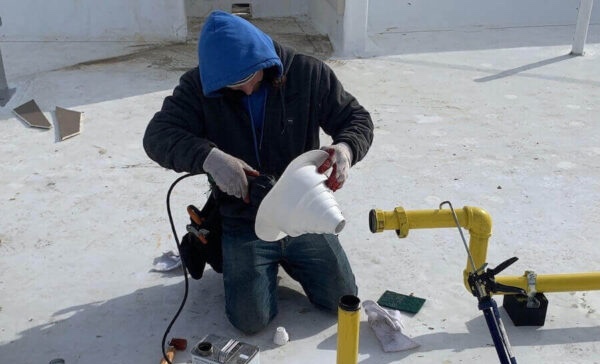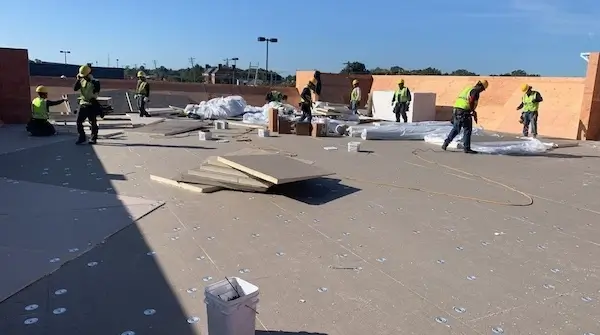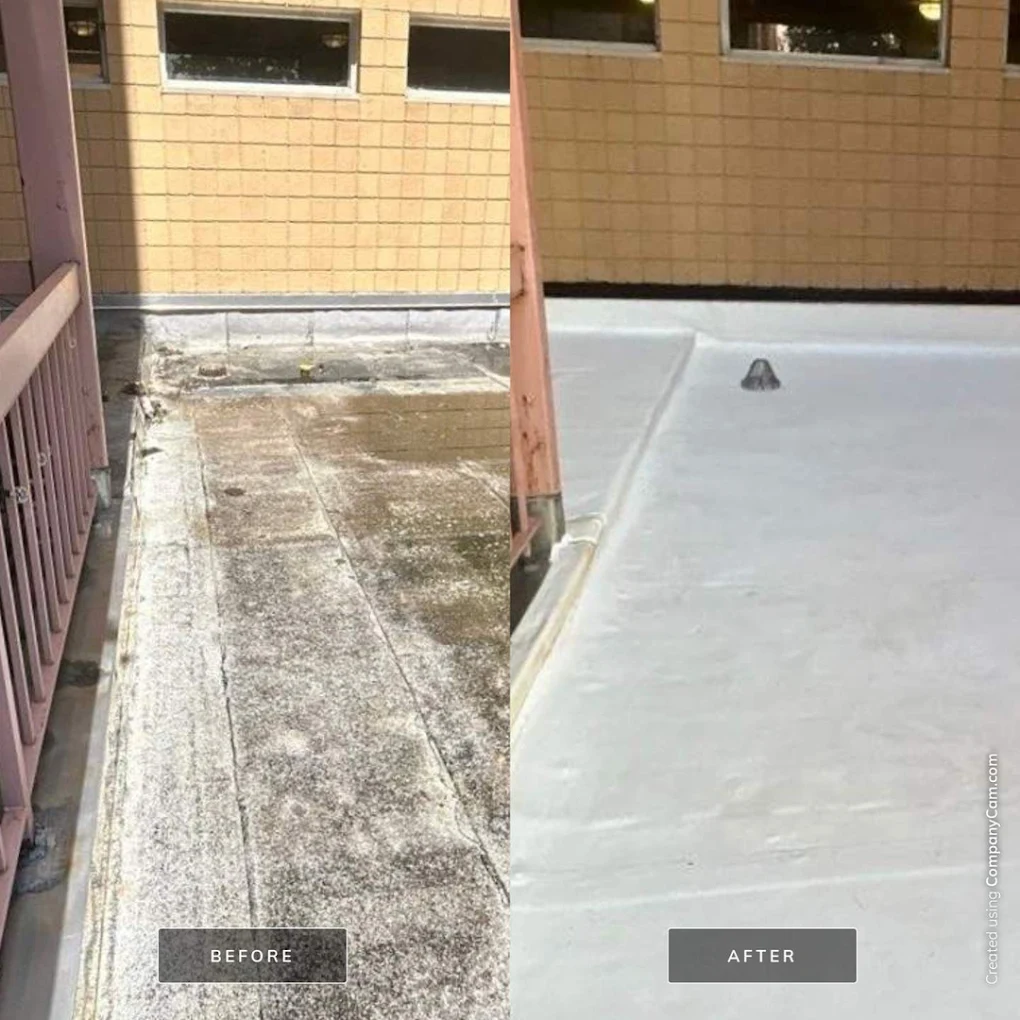Flat roofs work through a system of subtle slopes, drainage points, crickets membranes, and structural planning that keeps water moving across the surface. Our team works on these systems every week on Maryland homes and commercial buildings. We see how a flat roof succeeds when the design supports the movement of water and we also see how small mistakes can create years of stress for owners. This guide explains how the roof drainage system works, how water moves across the surface, and what we do to correct drainage issues.

Why Flat Roof Drainage Matters
Drainage directly affects the lifespan of a flat roof. When water sits for long periods, it slowly pushes into seams and small openings. A flat roof with predictable drainage handles these conditions without leaks or damage. A dependable drainage system also helps preserve the warranty on TPO, EPDM, and modified bitumen installations.
What Helps a Flat Roof Drain Correctly
A flat roof drains well when the slope, materials, and layout work together. Several elements shape the system.
Minimum Required Slope
In roofing, the word “flat” usually means a low-slope roof, not a perfectly level surface. Most flat roofs have a slight pitch, such as 1/4 inch per foot. That small slope gives gravity enough help to move the water towards drains, scuppers, or gutters. The slope is sometimes built into the roof deck or created using tapered insulation board. The slope is subtle, but it needs to be consistent. We check this carefully during inspections. A small dip (even half an inch deep) creates a ponding area, and these small dips often form after years of foot traffic, HVAC work, or natural settling.
Surface Materials
Once the slope is in place, the surface directs water toward its exit points. Flat roofs typically use TPO, EPDM, PVC, or modified bitumen. Each flat roof material reacts differently to long term moisture, but all of them depend on clear drainage paths. The membrane, seams, and flashing all influence how smoothly that water travels.
Flashing around walls, edges, and penetrations keeps water from entering the structure. When flashing pulls loose, folds upward, or cracks at the base, water slows down and gathers in unwanted areas. The membrane also affects flow. Smooth TPO or PVC sheets let water travel easily, while older modified bitumen surfaces with mineral granules slow movement. This isn’t a problem as long as the slope is correct.
Roof Shape and Layout
Many commercial buildings have parapet walls. These walls require internal drains or scuppers since water cannot run off the sides. Residential homes with small additions or garages sometimes use a flat roof that drains toward a gutter. Rooftop equipment, such as HVAC units, can interrupt the slope if the design does not account for its placement. We adjust tapered insulation around these areas to keep the path clear.
Drain Placement and System Design
Drain placement determines how fast the water clears the surface. We place drains at the low points we create using tapered insulation. A drain in a high spot does not collect water. A drain placed near a sagging area collects only part of the water and leaves the rest behind.
Our crews review the structure before installing any membrane. We run straight edges across the surface. We check the deck for deflection. We plan drain placement based on the natural shape of the building and where the owner wants runoff directed.

Main Types of Flat Roof Drainage Systems
Drainage systems fall into three main categories. Each system works when installed and maintained correctly.
Internal Drains
Internal drains sit at the lowest points of the roof. Water moves toward them and enters a drain bowl. The line carries the water through the interior of the building and finally releases it outside. These drains work well on large commercial roofs or buildings with parapet walls. They protect drain lines from freezing because the plumbing sits in warmer areas of the structure.
These drains often require strainers to prevent leaves, twigs, and other debris from entering the piping. A clogged internal drain often leads to ponding. When we install these systems, we place them in strategic low points and use tapered insulation to create a defined slope.
Scuppers
Scuppers are openings in the parapet walls that allow water to exit the roof. Open scuppers simply let water flow out. Scuppers with conductor heads and downspouts direct the water down the wall and away from the building. The size of the opening matters. The roof needs enough space for heavy rainfall to escape without backing up.
We install scuppers on mid-sized commercial roofs or buildings where an internal drain is not the most suitable option. Placement of scuppers also matters and must match the slope and flow of water. We often correct older roofs where the scuppers sit in slightly high spots. A few adjustments with tapered insulation can solve the issue and improve drainage across the entire edge.
Gutters and Downspouts
Some flat roofs drain into exterior gutters. These systems appear often on residential additions and small commercial properties. A gutter system works effectively when the roof’s pitch directs water toward the downspouts without slowing the flow. The downspouts must be large enough to handle heavy storms. We upgrade these systems with wide-mouth outlets or larger downspouts when the roof needs more capacity.
Gutters require maintenance. Leaves, branches, and granules build up quickly. A clogged gutter creates overflow that runs down the siding or pools near the foundation. Owners with trees near the roof should monitor these systems frequently. We can also install gutter guards to prevent debris from getting into the gutter system.
Common Drainage Problems on Flat Roofs
Buildings develop drainage issues from age, movement, poor installation, or lack of maintenance. Here are the flat roof drainage issues we uncover most often.
Ponding Water
Ponding water forms when the slope is weak or the drains cannot keep up. A pond that lasts more than 48 hours indicates a drainage problem. The membrane stays saturated. UV exposure accelerates surface wear. The deck supports more weight during storms. Large ponds increase risk of finding a leak on your flat roof. We document these areas during inspections so owners have a clear picture of the roof’s condition.
Clogged Drains and Scuppers
Leaves, twigs, gravel, and even small plastic debris from roof work can block drains. A blocked drain forces water to spread across the surface. Scuppers clogged with leaves often cause water to rise along the parapet walls. Regular cleaning prevents these issues.
Roof Deflection or Structural Settling
Buildings shift over time. Long span bar joists or older rafters may bow slightly. This movement creates dips that interrupt the slope. Ponding appears first in these spots. During winter, these areas show freeze patterns that reveal how the water moves. We use this information to plan repairs.
Membrane Wear Or Damage
Every flat roof material handles water differently. TPO and PVC resist water well, but punctures from tools or foot traffic can harm the surface. Modified bitumen ages gradually and becomes less flexible over time. EPDM can stretch, but sharp edges or loose fasteners may leave openings. When damage forms, the roof can redirect water in unexpected ways. These changes affect drainage patterns and create new ponding areas.
How to Know When a Flat Roof Is Not Draining Correctly
A roof that struggles with drainage shows visible signs. Many building owners spot these signs before major damage occurs.
• Water that remains on the surface longer than 48 hours.
• Overflowing gutters or scuppers.
• Water stains on ceilings or walls.
• Soft spots or bubbling on the membrane.
• Ice buildup during winter in specific patterns near drains or low points.
Owners who see one or more of these clues should schedule a drainage evaluation. Early action prevents structural deterioration and larger repair costs.

How Our Team Improves Flat Roof Drainage
We work on projects across Maryland that involve correcting or redesigning drainage systems. Each building has different needs, but the process often includes several common steps.
Resloping and Tapered Insulation
We review the structure and create a plan for a new slope. Tapered insulation is a reliable method for shaping the roof. We use materials from industry-leading manufacturers like Johns Manville because they integrate well with the different types of flat roof membranes we install. Resloping eliminates ponding and moves water toward planned drain points.
Installing New Internal Drains or Scuppers
A roof with chronic drainage issues sometimes needs new drainage points. We install internal drains when the building supports interior piping. For buildings with parapet walls that do not support plumbing routes, we add new scuppers. We size the openings for heavy rainfall and place them at true low points.
Gutter and Downspout Upgrades
Some roofs only need better gutter systems. We install larger downspouts or upgrade to commercial-sized gutters. These improvements remove water faster and prevent backflow onto the roof surface.
Preventative Maintenance Programs
We offer scheduled maintenance that keeps drains clear and identifies problems early. Our team checks for clogs, removes debris, tests drain flow, and inspects seams and penetrations. Owners with maintenance programs experience fewer leaks and longer membrane life.
Our Experience With Flat Roof Systems Across Maryland
Maryland has a mix of small and large flat roofs. You see them on Baltimore rowhomes, porch roofs, garages, and additions. You also see them in shopping centers, schools, warehouses, and multi-family buildings.
The drainage strategy can be very different. A small residential flat roof may send water into standard gutters and downspouts. A large commercial roof might rely on internal drains and long runs of concealed piping. When we work on either type, we match the drainage system to the size of the roof and the way the building is built.
Our Inspection and Diagnostic Process
At RoofPRO, we spend a lot of time fixing commercial and flat roof problems that start with poor drainage. When inspecting and evaluating a roof, we examine the entire system. Drainage depends on more than one part of the roof.
We start with a visual inspection. We walk the full roof and map the low points. We check drain strainers and scuppers. We look at patches, seams, and penetrations. We note the areas that show UV wear or blistering. We also look at rooftop equipment and how the supports interact with the slope.
We use straight edges to measure sag. We review the layout of tapered insulation if the building has an existing system. We also use thermal imaging on some projects. Thermal imaging helps reveal moisture under the membrane. These areas often connect to slow drainage or hidden areas of ponding. When the weather allows, we test the drains during rainfall. This shows how fast the water moves. All of this information is compiled into a written report and a repair plan.
Get a Flat Roof Drainage Evaluation
A flat roof with strong drainage performs better, lasts longer, and stays more predictable through weather shifts. Our team can assess your roof, identify the issues, and develop a plan to improve the water flow across the surface. We work across Maryland and provide detailed reporting so owners understand every step of the process.
Contact RoofPRO for a drainage evaluation, repair, or full flat roof project. We can help you improve the lifespan and reliability of your building.

Author Bio
Tim Taylor – Owner & Founder of RoofPR
Tim Taylor began his roofing career in 2003 and founded RoofPRO in 2004 with a mission to fix the poor workmanship that often causes roof leaks. With over 20 years of hands-on experience, he’s earned elite credentials like CertainTeed’s ShingleMaster Wizard certification, HAAG inspection certifications, and OSHA safety training. His expertise in leak repair, flashing repair, and post-storm restoration has made RoofPRO one of Maryland’s most trusted roofing companies. Tim continues to lead with the same principle that built his reputation—roof it right the first time.

